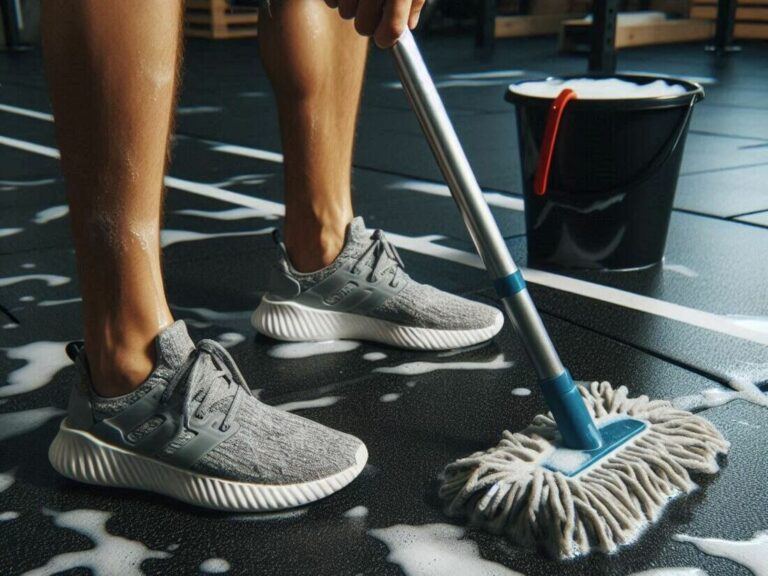Dreaming of crushing your fitness goals with the convenience of a home gym, but stuck staring at a tiny apartment corner or a shared living space? We get it.
Limited square footage can feel like a major roadblock, making the idea of fitting in treadmills, weight racks, and workout mats seem impossible.
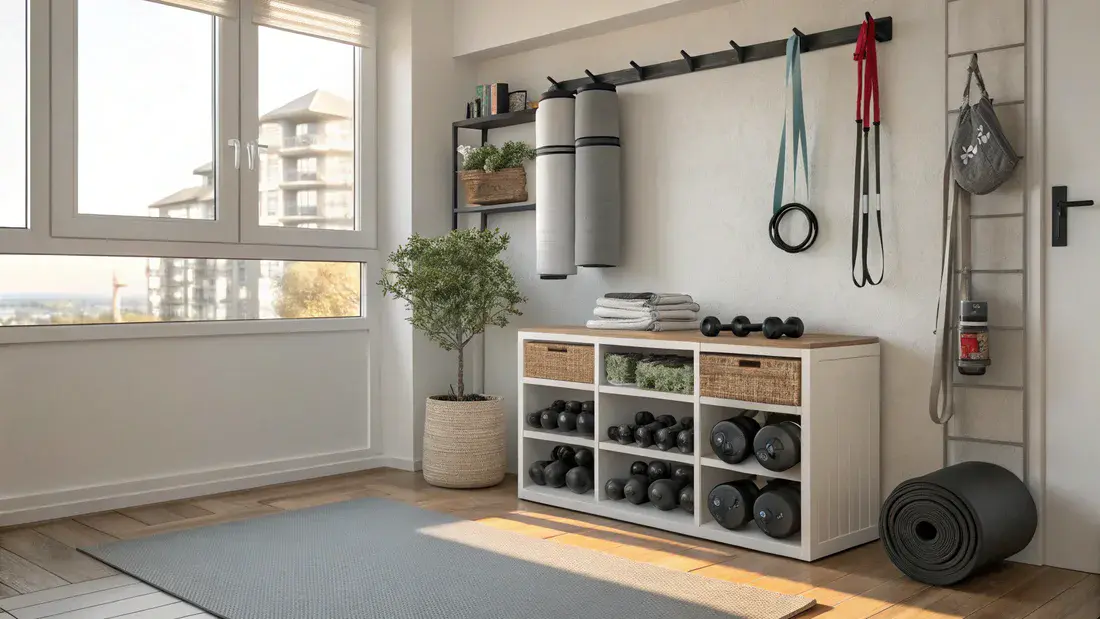
But what if we told you that your lack of a sprawling spare room doesn’t mean sacrificing your health journey?
The truth is, creating a functional and even inspiring home gym in a small space is entirely possible.
It just requires a shift in perspective – focusing on smart solutions, multi-functional pieces, and maximizing every available inch, both horizontally and vertically.
Forget the idea that you need a dedicated room; creativity is your most valuable asset here.
This post is your ultimate guide to unlocking that potential.
We’ve gathered 15 clever, actionable ideas designed specifically for compact living.
Get ready to transform that neglected corner or awkward nook into a powerful workout zone that fuels your motivation and makes fitness more accessible than ever.
Let’s dive in and reclaim your space!
Maximize Your Space – 15 Ingenious Small Home Gym Solutions
Here are 15 practical ways to build an effective home gym, even when space is at a premium:
1. Embrace Adjustable Weights (Dumbbells/Kettlebells)
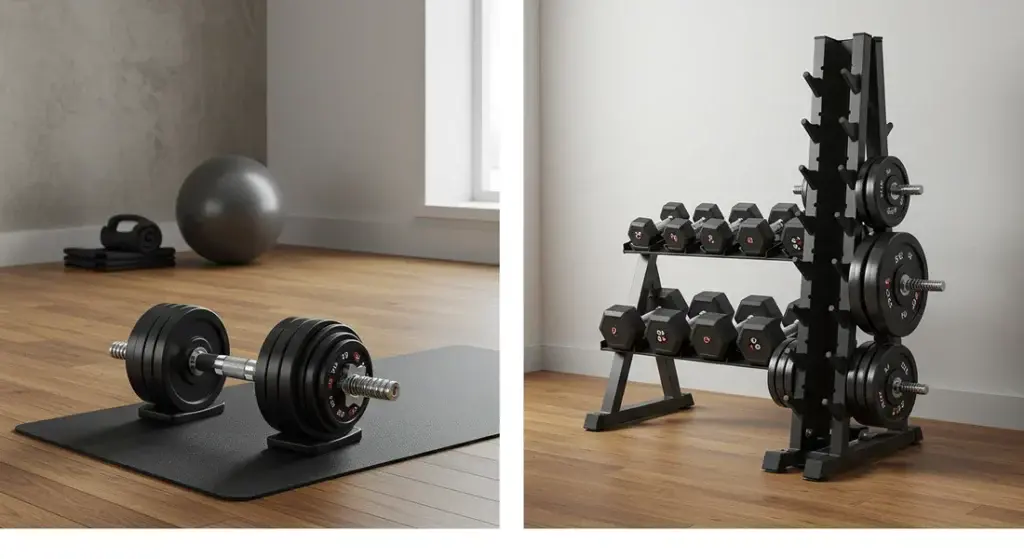
- What it is: Single pairs of dumbbells or kettlebells where you can easily change the weight, usually via a dial or pin system.
- Why it’s Clever for Small Spaces: This is arguably the biggest space-saver for strength training. One compact set replaces an entire rack of 10, 15, or even 20+ individual weights, drastically reducing the floor space needed.
- Quick Tip: Popular options include Bowflex SelectTech dumbbells or PowerBlock adjustable weights. Store them neatly on a small stand or even under a sturdy bench.
- Another space-saving strength alternative: While adjustable weights are fantastic, if you’re exploring other minimal equipment options, you might be interested in sandbags.
Have a look at our post: Ditch The Dumbbells – Why A Sandbag Is The ONLY Home Gym Tool You Need.
2. Go Vertical with Wall Storage
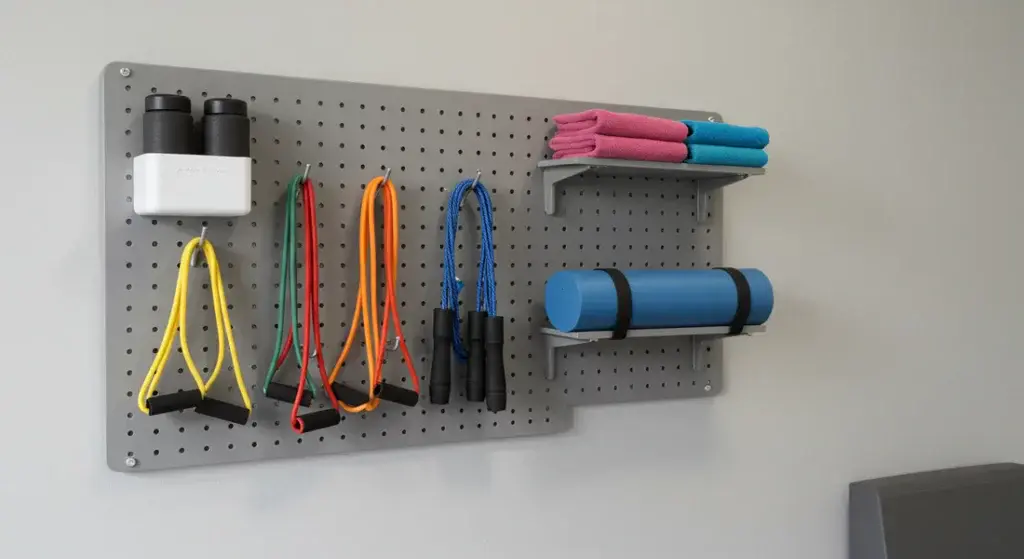
- What it is: Utilizing wall space for mounting shelves, hooks, or pegboards to store equipment.
- Why it’s Clever for Small Spaces: It gets bulky items like yoga mats, foam rollers, resistance bands, and jump ropes off the floor, freeing up valuable workout area and reducing clutter.
- Quick Tip: Pegboards are incredibly versatile – you can customize hook placements for various items. Consider floating shelves for a cleaner look.
3. Master the Suspension Trainer (TRX-style)
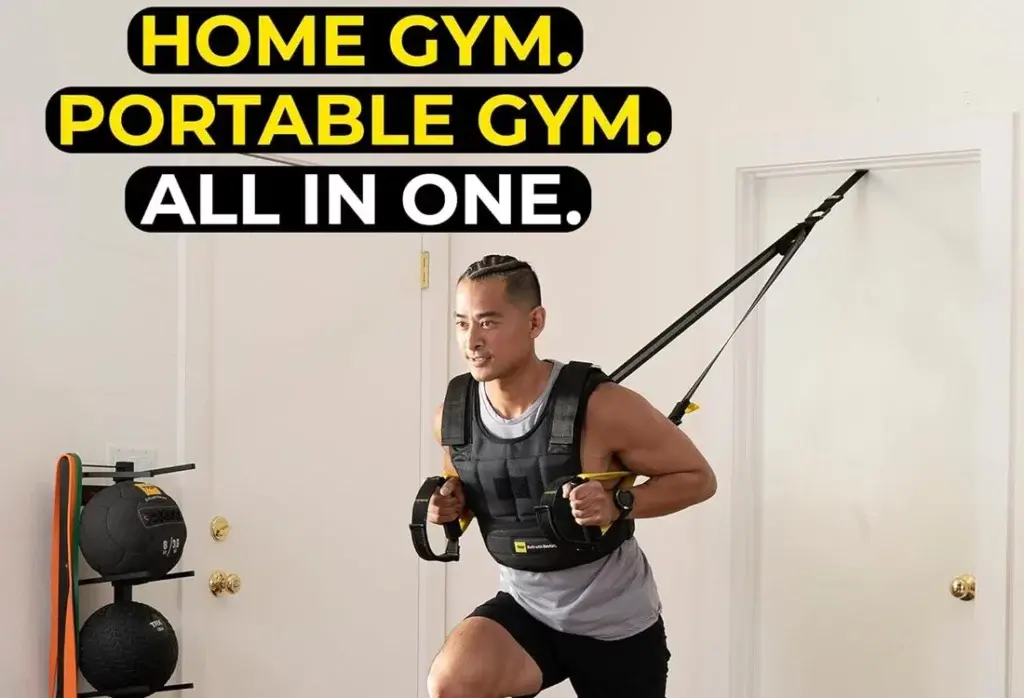
- What it is: A system of straps with handles that anchors to a sturdy point (door frame, ceiling mount, wall mount) allowing you to use your body weight for resistance exercises.
- Why it’s Clever for Small Spaces: It offers a full-body workout targeting strength, balance, and flexibility with virtually zero permanent footprint. When you’re done, it packs away into a small mesh bag.
- Quick Tip: Ensure you have a secure anchor point. Door anchors are convenient for renters, while ceiling/wall mounts offer more stability if permitted.
4. Invest in Fold-Away Cardio Machines
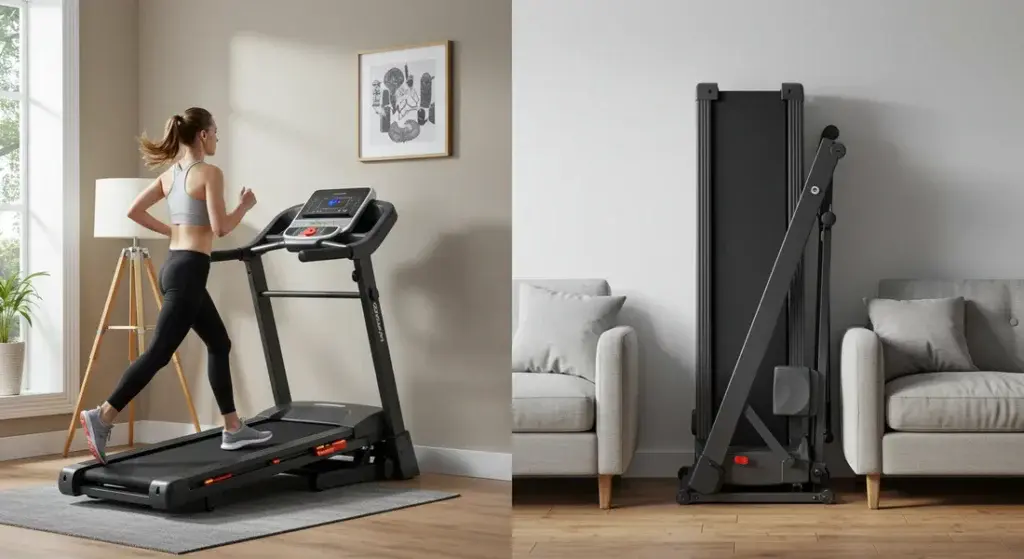
- What it is: Treadmills, exercise bikes, or rowing machines specifically designed to fold up compactly for storage.
- Why it’s Clever for Small Spaces: Cardio equipment is notoriously bulky. Foldable options allow you to have the benefits of cardio without dedicating permanent floor space. Many can be stored vertically against a wall or slid horizontally under a bed or sofa.
- Quick Tip: Check the folded dimensions carefully before buying to ensure it fits your intended storage space. Look for models with transport wheels.
5. Utilize Doorway Space (Pull-Up Bars/Resistance Band Anchors)

- What it is: Equipment designed to leverage the structural integrity of a standard doorway.
- Why it’s Clever for Small Spaces: It uses existing architecture, adding exercise variety (pull-ups, chin-ups, anchor points for band exercises) without consuming any floor or wall space when not in use (especially removable bars).
- Quick Tip: Opt for removable leverage-based pull-up bars if you’re renting or don’t want permanent fixtures. Simple webbing door anchors for resistance bands are also incredibly small and effective.
6. Think Multi-Functional Furniture (Storage Ottomans/Benches)

- What it is: Everyday furniture pieces that serve a dual purpose, offering hidden storage for gym gear.
- Why it’s Clever for Small Spaces: It seamlessly integrates storage into your living space. A stylish ottoman can hide yoga blocks and resistance bands, while a sturdy bench can double as a weight bench and store dumbbells underneath or inside.
- Quick Tip: Look for ottomans or benches with ample, easily accessible storage compartments. Ensure benches are rated for the weight you intend to use on them if using for exercise.
7. Corner the Market (Utilize Corner Shelving/Racks)
- What it is: Storage solutions specifically designed to fit into room corners.
- Why it’s Clever for Small Spaces: Corners are often awkward, dead space. Installing corner shelving units or a compact A-frame weight tree maximizes this often-neglected area for storing weights, accessories, or water bottles.
- Quick Tip: Measure your corner carefully. Tall, narrow corner units are particularly effective at maximizing vertical space.
8. Get Under It (Under-Bed/Sofa Storage Containers)
- What it is: Low-profile storage bins, often with wheels, designed to slide under furniture.
- Why it’s Clever for Small Spaces: It utilizes the often-wasted space beneath beds and sofas for storing flatter items like yoga mats, exercise sliders, resistance bands, or even disassembled adjustable weights.
- Quick Tip: Choose containers with lids to keep dust out. Wheeled versions make access much easier. Measure the clearance under your furniture first!
9. Resistance Bands – The Ultimate Space Savers
- What it is: Elastic bands of varying resistance levels used for strength training, stretching, and mobility.
- Why it’s Clever for Small Spaces: They are incredibly lightweight, portable, inexpensive, and take up almost zero space. You can store a full set in a small drawer or bag, yet they offer remarkable versatility for full-body workouts.
- Quick Tip: Get a set with varying resistance levels (light, medium, heavy) and styles (loop bands, tube bands with handles) for maximum exercise options.
10. Create a “Workout Zone” with Flooring/Mats
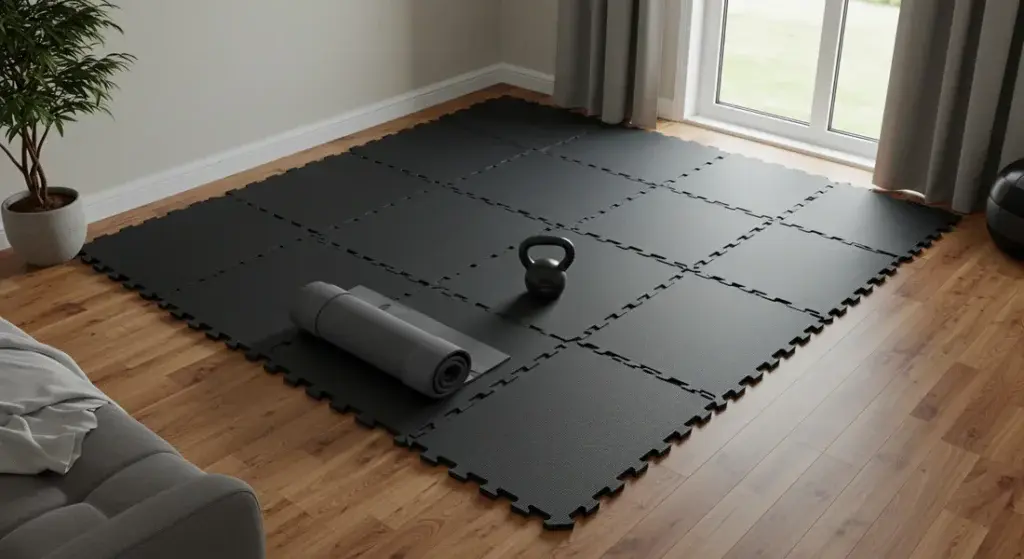
- What it is: Using specific flooring to visually and functionally define your workout space, even if it’s part of a larger room.
- Why it’s Clever for Small Spaces: It mentally separates your gym area, making it feel intentional. Interlocking foam tiles or a durable rubber mat protect your main floor, provide cushioning, and clearly mark the boundaries of your workout zone.
- Quick Tip: Choose mat thickness based on your activity (thicker for high-impact or weights). Interlocking tiles allow you to customize the size and shape easily.
11. Mount It – Foldable Squat Racks/Wall-Mounted Racks
- What it is: Sturdy steel racks for barbell exercises (squats, bench press) that can be folded flat against the wall.
- Why it’s Clever for Small Spaces: This is a game-changer for serious lifters in tight quarters. It provides the safety and functionality of a power rack but collapses to have a profile of only a few inches deep when not in use, freeing up significant floor space.
- Quick Tip: This requires secure wall mounting (preferably into studs) and is a larger investment, but invaluable if heavy lifting is a priority. Brands like PRx Performance or Rogue Fitness offer popular options.
12. Use Mirrors Strategically
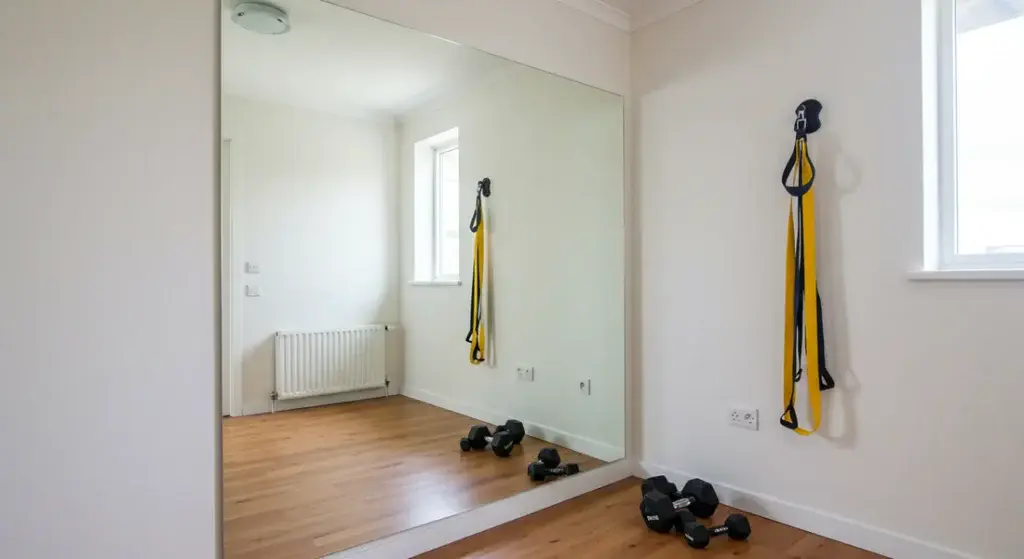
- What it is: Placing large mirrors within your workout area.
- Why it’s Clever for Small Spaces: Mirrors create an illusion of depth, making any small space feel significantly larger and brighter. Functionally, they are essential for monitoring your form during exercises to prevent injury and ensure effectiveness.
- Quick Tip: A large, simple wall-mounted mirror (like those used in dance studios) is often more effective and space-efficient than smaller, decorative ones. Position it where you can see yourself performing key movements.
13. Compact All-in-One Trainers (e.g., Resistance-Based Systems)
- What it is: Advanced fitness machines, often wall-mounted or freestanding but compact, that use digital resistance, cable systems, or specialized resistance mechanisms to offer a wide variety of exercises in one unit.
- Why it’s Clever for Small Spaces: They consolidate the function of multiple traditional gym machines into one sleek, space-efficient package. Ideal for those wanting guided workouts and diverse training options without clutter.
- Quick Tip: Examples range from high-end smart gyms like Tonal or FORME Life to more portable resistance systems like the MaxPRO Fitness or Kynseed KynSHOT. Research cost and features carefully.
14. The Power of Portability (Workout Boxes/Mobile Carts)
- What it is: Keeping your essential, smaller workout gear contained in a portable solution.
- Why it’s Clever for Small Spaces: Instead of having items scattered, a dedicated box, basket, or small rolling utility cart keeps everything together. You can easily move your “gym” to your workout spot and store it neatly away in a closet or corner afterward.
- Quick Tip: Use a cart with multiple tiers to organize different types of gear (bands on one level, small weights on another, timer/towel on top).
15. Prioritize & Declutter – The Minimalist Approach
- What it is: Consciously choosing only the equipment you will use most frequently and consistently, resisting the urge to buy every trendy gadget.
- Why it’s Clever for Small Spaces: Clutter is the enemy of small spaces. A minimalist gym with just a few versatile, high-quality pieces (like adjustable dumbbells, bands, and a mat) can be far more effective and less overwhelming than a cramped space filled with rarely used items.
- Quick Tip: Be honest about your preferred workout style. If you hate cardio, don’t force a folding treadmill into your space. Focus on tools that support the exercises you enjoy and will stick with.
Bonus Tips for Small Space Gym Success
- Combine & Conquer: The real magic happens when you layer these ideas. Use adjustable weights stored vertically on a corner shelf, define the area with mats, and use a storage ottoman nearby.
- Light it Right: Good lighting is crucial in small areas. Ensure your workout zone is well-lit (natural light if possible, supplemented by bright overhead or task lighting) to make it feel more open, energetic, and safe.
- Tidiness is Key: In a small space, clutter builds fast. Make it a habit to wipe down and put away every piece of equipment immediately after your workout.
- Measure Twice, Buy Once: Before investing in any equipment, especially larger pieces like foldable machines or racks, meticulously measure your available space – including height for vertical storage and clearance for movement.
Quick Recap – Key Takeaways & Smart Solutions
Feeling inspired but need a quick summary? Here are the core principles for maximizing your small home gym space:
Key Takeaways:
- Maximize Vertical Space: Don’t just think horizontally. Walls, doors, and corners offer prime real estate for storage and mounting equipment. Look up!
- Choose Multi-Functional & Adjustable Gear: Opt for equipment that serves multiple purposes (like storage benches) or replaces numerous items (like adjustable dumbbells/kettlebells). Versatility is key.
- Embrace Compact & Foldable Options: Many effective pieces of equipment, from cardio machines to squat racks, are now designed to fold away or have minimal footprints.
- Organization is Non-Negotiable: In a small space, clutter kills motivation and functionality. Implement smart storage solutions (under-bed, carts, pegboards) and keep your zone tidy.
- Prioritize Essentials: Focus on versatile equipment you’ll use consistently. A few well-chosen pieces are better than a cramped space full of gadgets you rarely touch.
- Define Your Zone: Even in a multi-use room, using mats, mirrors, or strategic lighting helps mentally separate your workout area and make it feel intentional.
Summary Table – Types of Small Space Solutions
| Solution Category | Examples | Key Space-Saving Benefit |
| Equipment Choices | Adjustable Weights, Suspension Trainers, Resistance Bands, Foldable Cardio | Reduces number of items or footprint size |
| Storage Strategies | Wall Mounts, Pegboards, Corner Shelves, Under-Bed Bins, Portable Carts | Gets gear off the floor, utilizes unused areas |
| Space Definition | Interlocking Mats, Large Mirrors, Good Lighting | Creates dedicated zone, enhances perceived size |
| Furniture Integration | Storage Ottomans, Benches with built-in storage | Hides equipment within everyday furniture |
| Minimalism | Focusing only on essential, versatile gear | Prevents clutter, maximizes usable space |
Small Space Gym FAQs
Here are answers to some common questions about setting up a gym in tight quarters:
Q1: Isn’t setting up even a small home gym expensive?
A: It doesn’t have to be! While high-tech gear like smart mirrors or foldable racks can be pricey, you can build an effective gym on a budget. Focus on essentials like resistance bands (very affordable), a good mat, maybe a doorway pull-up bar or a single set of adjustable dumbbells. DIY storage solutions also save money. Prioritize based on your budget and needs.
What about noise? I live in an apartment and don’t want to disturb neighbors.
A: This is a valid concern. Thick gym flooring or mats are essential to absorb impact and muffle sound. Opt for lower-impact exercises or equipment (resistance bands, bodyweight exercises, suspension trainers, ellipticals) over things like heavy deadlifts or jumping. Be mindful of workout timing, avoiding late nights or early mornings for potentially louder activities.
Q3: How can I stay motivated to work out in a small corner of my room?
A: Make the space inviting! Keep it extremely clean and organized. Use mirrors to make it feel bigger, ensure good lighting, and maybe add a small plant or motivational poster. Having everything readily accessible reduces friction. Most importantly, focus on the convenience – no travel time means more time for your actual workout!
Q4: If I could only buy ONE piece of equipment for a tiny space, what should it be?
A: This heavily depends on your goals!
For overall strength & versatility: A set of quality adjustable dumbbells is hard to beat.
For bodyweight fitness & portability: A suspension trainer (like TRX) offers incredible variety.
For ultra-minimalist & budget-friendly: A good set of resistance bands provides surprising workout potential.
Q5: I’m renting and can’t drill holes in the walls. What are my options?
A: Plenty! Focus on freestanding solutions: adjustable weights, resistance bands (use a door anchor), portable carts, under-bed storage, floor mats, storage ottomans, and removable doorway pull-up bars (leverage-based, not screw-in). You can still utilize vertical space with freestanding shelving units instead of wall-mounted ones.
Conclusion
There you have it – 15 practical and creative ways to prove that limited square footage is no match for your fitness ambitions.
As you can see, building a functional and motivating home gym in a small space isn’t just possible; it can be an exciting design challenge!
By embracing vertical storage, choosing multi-functional equipment, and utilizing often-overlooked nooks and crannies, you can carve out a dedicated workout sanctuary almost anywhere.
Forget the commute, the crowded gym floors, and the membership fees.
The ultimate convenience of having a workout space tailored to your needs, right in your own home, is within reach.
Don’t feel overwhelmed – start small.
Pick one or two ideas from this list that resonate most with your space and budget, and begin building your perfect compact gym today.
What are your favorite small space gym hacks? Share your tips in the comments below!


